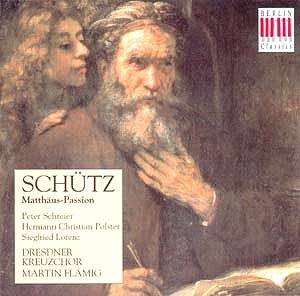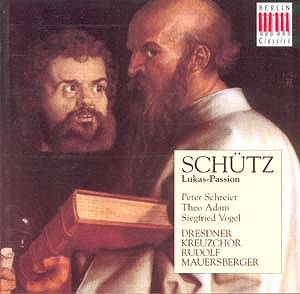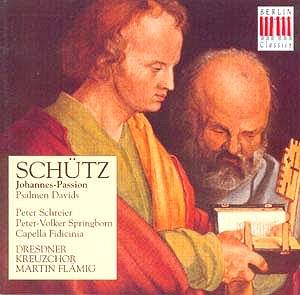HEINRICH SCHÜTZ
(1585-1672)
Matthäus-Passion SWV 479 *
 Peter Schreier, tenor Peter Schreier, tenor
Hermann Christian Polster, bass
Siefgried Lorenz, baritone
Hans-Joachim Rotzsch, tenor
Hans-Jürgen Wachsmuth, tenor
Armin Ude, tenor
Gothart Stier, baritone
Dresdner Kreuzchor, Martin Fläming
Rec: * Oct. 1973
 BERLIN CLASSICS 0090102BC
[57.16] BERLIN CLASSICS 0090102BC
[57.16]
Crotchet
AmazonUK
AmazonUS |
 |
Lukas-Passion SWV 480 **
 Peter Schreier, tenor Peter Schreier, tenor
Theo Adam, bass
Siefgried Vogel, bass
Hans-Joachim Rotzsch, tenor
Rolf Apreck, tenor
Günther Lieb, baritone
Dresdner Kreuzchor, Rudolf Mauersberger
Rec: Oct. and Dec. 1965
 BERLIN CLASSICS 009207BC
[61.30] BERLIN CLASSICS 009207BC
[61.30]
|
 |
Johannes-Passion SWV 481 ***
 Peter Schreier, tenor Peter Schreier, tenor
Peter-Volker Springborn, bass
Hans-Joachim Rotzsch, tenor
Hans-Jürgen Wachsmuth, tenor
Gothart Stier, baritone
Fred Maiwald, soprano
Dresdner Kreuzchor, Martin Fläming
Excerpts from Psalms of David SWV 40, 43, 42, 44 ****
 Dresdner Kreuzchor, Martin
Fläming Dresdner Kreuzchor, Martin
Fläming
Capella Fidicinia, Hans Grauss_
Rec: *** Oct. and Nov. 1972; **** Jan. and Apr. 1975.
 BERLIN CLASSICS 0090092BC
[25.52]+[21.23] BERLIN CLASSICS 0090092BC
[25.52]+[21.23]
AmazonUS |
 |
Heinrich Schütz was one of Germany's most important composers of the
17th century. Standing at the cross-roads of Renaissance and Baroque music,
he profited from a four-year stay in Venice, where he studied with Giovanni
Gabrieli, to learn "nuove musiche". This new form was to break with
the long tradition of music designed solely to reflect the divine order of
things and praise God, and to be more appealing to listeners, through more
varied melodies and accompaniments.
Nevertheless, in a period of fecund maturity, Schütz returned to the
more traditional style of composing. These three passions all date from the
latter decades of Schütz's life - from the period between the late 1640s
and the 1660s.
It is useful to put into perspective the role of sacred music in the 17th
century. Principally designed to praise God, music was performed in churches
by men only. The period up until the 17th century saw music that was essentially
an extension of Gregorian chants - a cappella works with vocal soloists,
choirs, or a combination of the two. Soloists declaimed more than they sang.
Schütz's passions follow this tradition. Scored for several soloists
and choir, they all present the story of the passion, that of Jesus's suffering
and death, according to the various gospels that relate this story. As far
back as the story of the passion goes, this form of performance seems to
have a long history as well. Gospel readings of the passions were probably
made as early as the ninth century (if not even longer), when a deacon, priest
and subdeacon would read the different parts of the gospel (the evangelist,
Christ and the other people) in varied registers.
These passions can therefore be seen as a continuation of an ancient practice,
with the difference that choirs are also used. Each of them features an
evangelist (Peter Schreier) recounting the story of Christ's punishment and
death, in alternation with other characters (Judas, Peter, Pilate, etc.),
and a choir.
The St. Matthew Passion is the last of the three passions written
by Schütz. At the time, in the 1660s, he was already around 80 years
old - almost a Methuselah for that time. It was performed for the first time
in 1666, but not published until after Schütz's death. Like the other
passions, this focus of this work is the recitative by the evangelist. He
tells the tale of the passion in a very simple manner - the music itself
is very limited, almost stripped to its most minimal aspects. The single
voices echoes through the church, as the words take on more importance than
the melodies. (This style of recitative is not that much different than that
of Bach, 150 years later.)
Interspersed between the recitatives of the evangelist and other players
in this drama are short choral movements representing the crowd. These arrive
like cool breezes that sweep away the ascetic nature of the recitatives.
Sometimes in canon, sometimes in counterpoint, the choral movements are rich
and varied. Yet the music remains restrained. The passion here is more meditative
than those of Bach or other later composers. Schütz's use of only voices,
singing only a limited number of notes, in simple, fixed intervals, with
no accompaniment, maintains the focus on the text rather than the music.
The St. Luke Passion is, naturally, similar to the St. Matthew Passion.
Written in the 1650s, but only completed in the following decade, with the
other two passions, it features even shorter choral works than the St. Matthew
Passion, and is a much more intimate work as a result of this.
If anything, this passion shows a higher level of vocal emotion than the
St. Matthew. There are fewer soloists, and their parts have less melodic
range. The singers must attain a higher level of expressiveness, and they
all do.
The St. John Passion, the earliest of the three, written in the 1640s,
has the smallest group of soloists, only six. This is also the shortest of
the three works, at around 36 minutes. Similar to the other two passions,
it can be seen that Schütz had not yet fully established the full range
of techniques that would reach their pinnacle in the St. Matthew Passion.
Even more spare than the other two passions, this work nevertheless features
some excellent choral movements.
Added to the recording of the St. John Passion are four Psalms of David.
These earlier works (1619) are totally different than the passions; these
are complex pieces featuring double choirs, with varied forms of instrumental
accompaniment. Emotive and solemn, these works are much closer to Italian
madrigals in their melodic structure and arrangements. Horns float above
the voices as the choirs weave arabesques of sound. This is a much different
Schütz than that of the passions - here, the music goes beyond the simple
emotion of voices to attain a much different effect.
Musically, the main attraction of the passions is, of course, Peter Schreier's
interpretation of the evangelist in each of them. No other singer "plays"
the role of the evangelist like Schreier: he is the epitome of the perfect
evangelist. His crystal-clear voice resounds with such purity that almost
every word he sings is a pleasure. In addition, this was probably his greatest
period as a performer.
Many of the other singers are good, but one reservation I have is related
to performance practice. It is not clear whether singers in this period used
vibrato much, if at all, and it sometimes shocks to hear the works sung with
a great deal of vibrato. The basses Hermann Christian Polster (St. Matthew
Passion) and Theo Adam (St. Luke Passion) are especially guilty of this.
While their voices are excellent, they tend to overdo it just a bit, and
it throws me out of any feeling of authenticity that may arise.
The unique texture of Schütz's choral movements calls for a talented
choir, and choirmaster. In all three recordings, the choir rises to the occasion
admirably, and the recordings themselves are excellent.
Excellent recordings of Schütz's three passions, featuring the magnificent
Peter Schreier as evangelist, in his prime. While the ascetic character of
these a cappella works may not appeal to all, they are worth having
just to hear Schreier in his element.
Kirk McElhearn
CONTACT DETAILS
http://www.edelclassics.com
EDEL/Berlin Classics discs CANNOT yet be ordered directly from the
website. However it is probably worth browsing anyway:
You can try:-
EDEL affiliates in UK and USA:
edel UK ltd.
12, Oval Road
NW1 7DH London
phone: 0044 207 48 24 848
fax: 0044 207 48 24 846
edel America Records, Inc.
1790 Broadway, 7th Floor
New York, NY 10019
phone: 001 212 5419700
fax: 001 212 6648391

